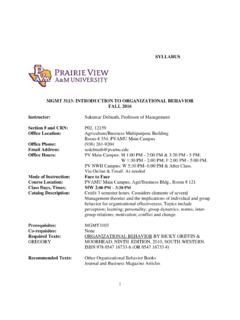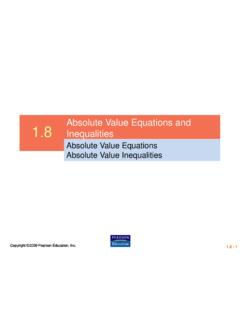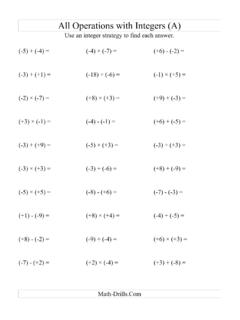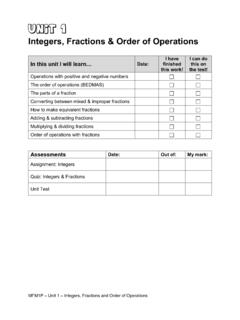Transcription of WORKING WITH INTEGERS: 1. Adding Rules
1 WORKING WITH INTEGERS: 1. Adding Rules : Positive + Positive = Positive: 5 + 4 = 9 Negative + Negative = Negative: (- 7) + (- 2) = - 9 The sum of a negative and a positive number: First subtract: The answer gets the sign of the larger number (- 7) + 4 = -3 6 + (-9) = - 3 (- 3) + 7 = 4 5 + ( -3) = 2 2. Subtracting Rules : Negative - Positive = Negative: (- 5) - 3 = -5 + (-3) = -8 Positive - Negative = Positive + Positive = Positive: 5 - (-3) = 5 + 3 = 8 Negative - Negative = Negative + Positive = Use the sign of the larger number and subtract (Change double negatives to a positive) (-5) - (-3) = ( -5) + 3 = -2 (-3) - ( -5) = (-3) + 5 = 2 3.
2 Multiplying Rules : Positive x Positive = Positive: 3 x 2 = 6 Negative x Negative = Positive: (-2) x (-8) = 16 Negative x Positive = Negative: (-3) x 4 = -12 Positive x Negative = Negative: 3 x (-4) = -12 4. Dividing Rules : Positive Positive = Positive: 12 3 = 4 Negative Negative = Positive: (-12) (-3) = 4 Negative Positive = Negative: (-12) 3 = -4 Positive Negative = Negative: 12 (-3) = -4 Tips: 1. When WORKING with Rules for positive and negative numbers try and think of weight loss or balancing a check book to help solidify why this works.
3 2. Using a number line showing both sides of 0 is very helpful to help develop the understanding of WORKING with positive and negative numbers/integers. WHAT ARE EXPONENTS? Exponents are sometimes referred to as powers and mean the number of times the 'base' is being multiplied. In algebra, exponents are used frequently. In the example below, you would say: Four to the power of 2 or four raised to the second power or four to the second power. This would mean 4 x 4 or (4) (4) or 4 4. Simplified the example would be 16.
4 If the power/exponent of a number is 1, the number will always equal itself. In other words, in our example if the exponent 2 was a 1, simplified the example would then be 4. Exponent Rules When WORKING with exponents there are certain Rules you'll need to remember. When you are multiplying terms with the same base you can add the exponents. This means: 4 x 4 x 4 x 4 x 4 x 4 x 4 or 4 4 4 4 4 4 4 When you are dividing terms with the same base you can subtract the exponents. This means: 4 x 4 x 4 or 4 4 4 When parentheses are involved - you multiply.
5 (83)2 =86 yayb = y (a+b) yaxa = (yx)a Squared ( Cubed ( and 0's When you multiply a number by itself it is referred to as being 'squared'. 42 is the same as saying "4 squared" which is equal to 16. If you multiply 4 x 4 x 4 which is 43 it is called 4 cubed. Squaring is raising to the second power, cubing is raising to the third power. Raising something to a power of 1 means nothing at all; the base term remains the same. Now for the part that doesn't seem logical. When you raise a base to the power of 0, it equals 1.))
6 Any number raised to the power of 0 equals 1 and 0 raised to any exponent or power is 0! Order of Operations: Rules 1. Calculations must be done from left to right. 2. Calculations in brackets (parenthesis) are done first. When you have more than one set of brackets, do the inner brackets first. NOTE: Brackets and parenthesis are known also known as grouping symbols. 3. Exponents (or radicals) must be done next. 4. Multiply and divide in the order the operations occur. So, what you SEE first, DO first!
7 5. Add and subtract in the order the operations occur. So, what you SEE first, DO first! Acronyms to Help you Remember How will you remember this order? Try the following Acronyms: Please Excuse My Dear Aunt Sally (Parenthesis, Exponents, Multiply, Divide, Add, Subtract) BEDMAS (Brackets, Exponents, Divide, Multiply, Add, Subtract) OR Big Elephants Destroy Mice And Snails (Brackets, Exponents, Divide, Multiply, Add, Subtract) Pink Elephants Destroy Mice And Snails (Parenthesis, Exponents, Divide, Multiply, Add, Subtract) The point is to find SOMETHING that works for you.
8 These are only suggestions. Examples 12 4 + 32 12 4 + 9 3 + 9 12 Rule 3: Exponent first Rule 4: Multiply or Divide as they appear Rule 5: Add or Subtract as they appear (42 + 5) - 3 21 - 3 18 Rule 2: Everything in the brackets first Rule 5: Add or Subtract as they appear 20 (12 - 2) X 32 - 2 20 10 X 32 - 2 20 10 X 9 - 2 18 - 2 16 Rule 2: Everything in the brackets first Rule 3: Exponents Rule 4: Multiply and Divide as they appear Rule 5: Add or Subtract as they appear Does It Make a Difference?
9 What If I Don't Use the Order of Operations? Mathematicians were very careful when they developed the order of operations. Without the correct order, watch what happens: 15 + 5 X 10 -- Without following the correct order, I know that 15+5=20 multiplied by 10 gives me the answer of 200. 15 + 5 X 10 -- Following the order of operations, I know that 5X10 = 50 plus 15 = 65. This is the correct answer, the above is not! You can see that it is absolutely critical to follow the order of operations. Some of the most frequent errors students make occur when they do not follow the order of operations when solving mathematical problems.
10 Students can often be fluent in computational work yet do not follow procedures. Use the handy acronyms to ensure that you never make this mistake again. Laws of Exponents Here are the Laws (explanations follow): Law Example x1 = x 61 = 6 x0 = 1 70 = 1 x-1 = 1/x 4-1 = 1/4 xmxn = xm+n x2x3 = x2+3 = x5 xm/xn = xm-n x6/x2 = x6-2 = x4 (xm)n = xmn (x2)3 = x2 3 = x6 (xy)n = xnyn (xy)3 = x3y3 (x/y)n = xn/yn (x/y)2 = x2 / y2 x-n = 1/xn x-3 = 1/x3 And the law about Fractional Exponents: Laws Explained The first three laws above (x1 = x, x0 = 1 and x-1 = 1/x) are just part of the natural sequence of exponents.

















